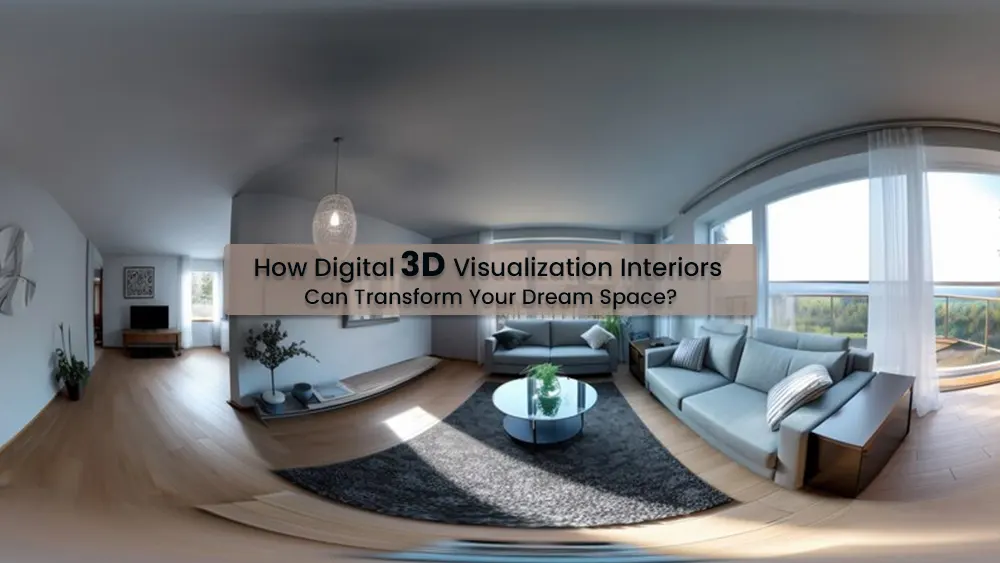The process of creating three-dimensional models is called 3D visualisation, sometimes referred to as 3D rendering, 3D graphics, or computer-generated images. These can include architectural blueprints and interior designs in addition to figures and landscapes.
As a result of these implications, there are numerous opportunities for the architectural design industry. Previously, to communicate concepts and schemes to clients, architects and interior designers relied on exact and time-consuming illustrations, physical modeling, and technical drawings.
As 3D graphics artists create 3D renderings of buildings and interiors, 3D digital visualisation is revolutionizing the fields of interior design and architecture.
Let us now understand the benefits of digital 3D visualisation for clients.
Digital 3D Visualisation: A Game-Changer in the Interior Designing Industry
- Creates Visual Impact: 3D visualisation provides realism and striking visuals. They make it possible for designers to communicate their concepts more clearly. It improves the efficiency and smoothness of the design process. By incorporating 3D visualisation into workflows, clients can improve their communication with interior designers. Making decisions is also expedited by it. It results in better project outcomes and increased client satisfaction.
- Inexpensive & Quick: The project can be finished more quickly with the use of 3D visualisation. Interior designers and clients can communicate more efficiently and make quick and better decisions. It is difficult to truly capture the svelte design of a design using traditional 2D modeling. Designers are therefore compelled to create several prototypes to account for any significant changes to the design.
- Flexibility: Architectural renderings are very helpful when your customer’s requirements change because they are simple to adjust. Additionally, with ease of modification, 3D artists can create multiple photorealistic versions of an image, giving the client a choice.
- Easy Showcase of Project: Here, 3D visualisation is a useful resource. For clients, decision-makers, and designers, they facilitate collaboration by showcasing distinct possibilities. Designers can present visually appealing options to clients by utilizing 3D visualisation. These renderings depict a variety of room configurations accurately. Customers can view how furnishings and other components would be placed in the room.
- Streamlines workflow: Design exploration and modification can be done efficiently with the help of 3D visualisation software. By experimenting with various layouts, furniture configurations, and color schemes, designers can ensure optimal outcomes and streamline the design process.
Application of 3D Visualisation in Diverse Industries
- Residence Interiors: Help clients visualize their ideal kitchens, warm living rooms, and customized bedrooms.
- Commercial design: Draw in potential customers and investors by showcasing the beauty of restaurants and office spaces.
- Hospitality Design: Give visitors a thorough experience of hotels, resorts, and spas before making their reservations.
What is the Future of 3D Visualisation?
In the coming years, 3D visualisation will be used more and more in the architecture and interior design sectors since it produces high-quality models at a reasonable cost and speed. Virtual reality and architectural rendering are likely to merge to give clients an even more interactive experience before the project fully materializes according to their preferences. In the end, incorporating 3D rendering and visualisation into your design process can prove to be one of your company’s most valuable investments going forward.
Differentiation Between 3D Visualisation & Home Staging
- While home staging uses actual furniture, accessories, and other objects to create a specific style or feeling in the space, 3D visualisation uses 3D modeling software to create a virtual representation of the space.
- While home staging is restricted to the furniture and accessories already in place, 3D visualisation offers greater flexibility and customization.
- Compared to 3D visualisation, home staging is less expensive and takes less time, enabling prospective buyers to see the space in person.
- Home staging emphasizes the overall impression rather than specific details, whereas digital 3D visualisation demands painstaking attention to detail.
Takeaways
Digital 3D visualisation is gaining popularity in the interior designing industry. More interior designers are including this in their services and taking an edge ahead of their competitors. It helps in creating compelling designs and attracting more customers.
Caroline Interior Design provides a wide range of services from residential interior to commercial designing to home staging interior designing and 3D visualisation. So, if you are planning to renovate your home, consider us.

